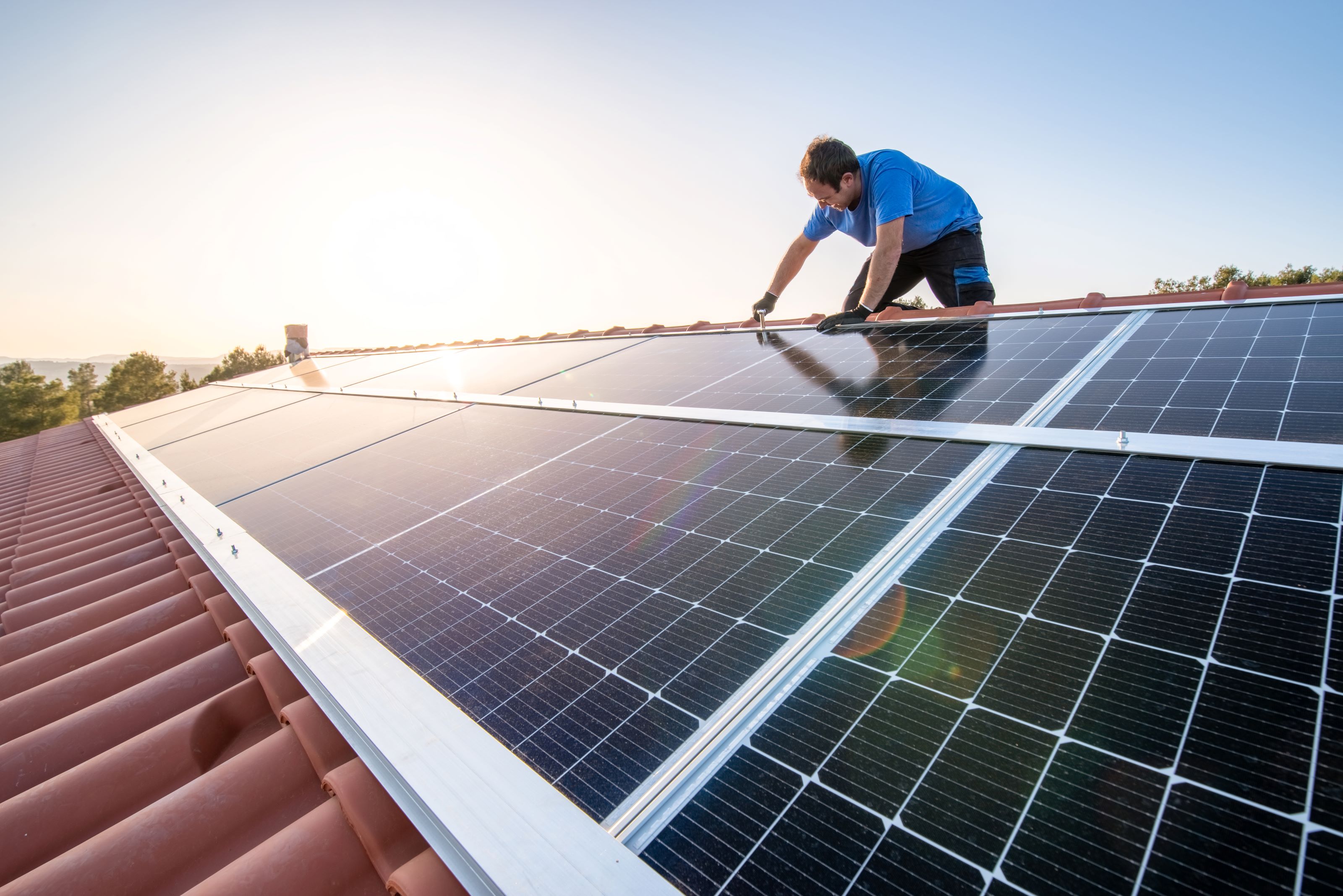2 Tax Credits to Claim for Energy-Efficient Home Renovations
These tax incentives reward energy-efficient home improvements in different ways. Which credit you use depends on the remodeling you do.


Two federal income tax credits reward energy-efficient home improvements very differently. Which credit you use depends on the improvements you make. Under federal tax law, new energy-efficient windows and doors don't count for much, but a system that uses renewable energy to power a home gets you a juicy tax break. The credits differ in other ways, with one imposing a cap and the other, for the most part, placing no such limit. Whether home improvements to a vacation home can qualify is another differentiator.
Neither of these tax credits is refundable; they can only be used to reduce the amount of income tax owed. If the credit exceeds your tax liability, the IRS won't refund you the difference. Eligible homeowners claim the credits on IRS Form 5695. Although the clock is ticking for the use of both home improvement credits, it may be less of a problem than you think.

The Residential Energy Efficiency Property Credit
If you installed an alternative energy system in your home that relies on a renewable source, this credit is for you. Renewable energy sources include solar, wind, geothermal or fuel cell technology to generate power. Solar panels, solar electric equipment, solar-powered water heaters and wind turbines are all eligible for the credit, whether they are installed in a primary residence or vacation home. A residential fuel cell, however, must be installed in your primary home to qualify.
The size of the tax credit varies and equals 26% of the cost of equipment and installation for renewable energy systems that were put in between 2020 and 2022. The credit falls to 23% in 2023 before expiring in 2024. Pre-2020 installations qualified for a 30% tax credit. There is no maximum dollar limit for solar, wind or geothermal equipment, but the tax credit for fuel cells is capped at $500 for each half-kilowatt of power capacity. Any unused portion of the credit can be carried over to future tax years.
Keep in mind you can only qualify for the credit once the alternative energy system has been installed. If you buy solar panels at the end of 2021 but don't install them until early 2022, you cannot claim the 26% tax credit on your 2021 return. Instead, you must wait and claim it when you file your 2022 taxes.
Homeowners who install a renewable energy system sometimes qualify for a rebate from their utility company, which will affect the tax credit amount. Although these rebates are nontaxable, the cost of the system is reduced by the rebate amount when you calculate your tax credit. For example, if you install a $20,000 solar system this year and the utility gives you a one-time installation rebate of $1,000, your tax credit is $4,940 (26% x [$20,000 - $1,000]).

The Nonbusiness Energy Property Credit
Although less valuable, this credit works for homeowners who make smaller energy-saving purchases for a primary residence in 2021. The credit applies to 10% of the cost of certain types of insulation, external windows and doors, and skylights. The credit also includes 100% of the cost of electric heat pumps and water heaters, some central air-conditioning systems, stoves that use biomass fuels, or similar energy-saving investments.
This may sound like a generous tax break, but it's not. The total credit is worth at most $500, and amounts taken in prior years count against it. For instance, if you claimed a $300 credit on your 2014 return for a natural gas furnace, you are only entitled to $200 more until the credit expires in 2022. The credit is also capped for many items. No more than $150 can be claimed for water heaters and furnaces, $200 for windows and $50 for a furnace-circulating fan.
Don't worry about the expiration dates for these tax credits. Congress has extended both credits many times, including retroactively. Some lawmakers want to make both credits permanent and even expand them. One Senate bill calls for raising the residential energy efficiency property credit to 30% and the maximum nonbusiness energy property credit to $1,500 per year. Whether these proposals will be enacted is unclear, but Democrats are pushing for them.
Profit and prosper with the best of Kiplinger's advice on investing, taxes, retirement, personal finance and much more. Delivered daily. Enter your email in the box and click Sign Me Up.

Joy is an experienced CPA and tax attorney with an L.L.M. in Taxation from New York University School of Law. After many years working for big law and accounting firms, Joy saw the light and now puts her education, legal experience and in-depth knowledge of federal tax law to use writing for Kiplinger. She writes and edits The Kiplinger Tax Letter and contributes federal tax and retirement stories to kiplinger.com and Kiplinger’s Retirement Report. Her articles have been picked up by the Washington Post and other media outlets. Joy has also appeared as a tax expert in newspapers, on television and on radio discussing federal tax developments.
-
 Are You Putting Yourself Last? The Cost Could Be Your Retirement
Are You Putting Yourself Last? The Cost Could Be Your RetirementIf you're part of the sandwich generation, it's critical that you don't let the needs of your aging parents come at the expense of your future.
-
 Time to Prepare for Disasters Like They Could Happen to You
Time to Prepare for Disasters Like They Could Happen to YouYou can no longer have the mindset that "that won't happen here." Because it absolutely could. As we head into 2026, consider making a disaster plan.
-
 How Women Will Lead a New Era in Charitable Giving
How Women Will Lead a New Era in Charitable GivingWomen will soon be in charge of trillions in charitable capital, through divorce, inheritance and their own investments. Here's how to use your share for good.
-
 Retirees in These 7 States Could Pay Less Property Taxes Next Year
Retirees in These 7 States Could Pay Less Property Taxes Next YearState Taxes Retirement property tax bills could be up to 65% cheaper for some older adults in 2026. Do you qualify?
-
 Estate Tax Quiz: Can You Pass the Test on the 40% Federal Rate?
Estate Tax Quiz: Can You Pass the Test on the 40% Federal Rate?Quiz How well do you know the new 2026 IRS rules for wealth transfer and the specific tax brackets that affect your heirs? Let's find out!
-
 Law Reversal Looming? Trump Eyes 2026 Gambling Winnings Tax Change
Law Reversal Looming? Trump Eyes 2026 Gambling Winnings Tax ChangeTax Deductions It's no secret that the IRS is coming after your gambling winnings in 2026. But how long will that last?
-
 5 Types of Gifts the IRS Won’t Tax: Even If They’re Big
5 Types of Gifts the IRS Won’t Tax: Even If They’re BigGift Tax Several categories of gifts don’t count toward annual gift tax limits. Here's what you need to know.
-
 The 'Scrooge' Strategy: How to Turn Your Old Junk Into a Tax Deduction
The 'Scrooge' Strategy: How to Turn Your Old Junk Into a Tax DeductionTax Deductions We break down the IRS rules for non-cash charitable contributions. Plus, here's a handy checklist before you donate to charity this year.
-
 IRS Says You Made a Tax Return Mistake? A New Law Could Help You Fight Back
IRS Says You Made a Tax Return Mistake? A New Law Could Help You Fight BackTax Law Updated taxpayer protections change what the IRS must explain on error notices and how long you have to respond.
-
 Tax Refund Alert: House GOP Predicts 'Average' $1,000 Payouts in 2026
Tax Refund Alert: House GOP Predicts 'Average' $1,000 Payouts in 2026Tax Refunds Here's how the IRS tax refund outlook for 2026 is changing and what steps you can take now to prepare.
-
 New IRS Changes to FSA Contribution Limits for 2026: What to Know
New IRS Changes to FSA Contribution Limits for 2026: What to KnowHealth Care Flexible Spending Accounts have tax advantages worth looking into, especially in light of new IRS changes.
